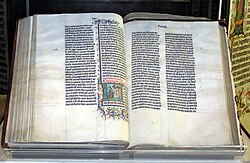Source criticism (biblical studies)
This article needs additional citations for verification. (August 2020) |
| Part of a series on the |
| Bible |
|---|
 |
|
Outline of Bible-related topics |
Source criticism, in
Principles
In general, the closer a source is to the event which it purports to describe, the more one can trust it to give an accurate description of what really happened. In the Bible where a variety of earlier sources have been quoted, the historian seeks to identify and date those sources used by biblical writers as the first step in evaluating their historical reliability.
In other cases, Bible scholars use the way a text is written (changes in style, vocabulary, repetitions, and the like) to determine what sources may have been used by a biblical author. With some reasonable guesswork it is possible to deduce sources not identified as such (e.g., genealogies). Some inter-biblical sources can be determined by virtue of the fact that the source is still extant, for example, where the Books of Chronicles quotes or retells the accounts of the books of Samuel and Kings.
Tanakh
Source criticism has been applied to several parts of the
Documentary hypothesis
The documentary hypothesis considers the sources for the
- The Jahwist (J) source is characterized by calling God "YHWH", depicts him as human-like, and is especially concerned with the kingdom of Judah. It is thought to have been written c. 950 BCE.
- The Elohist (E) source is characterized by calling God "Elohim" and deals more with the kingdom of Israel. It is thought to have been written c. 850 BCE.
- The Deuteronomic (D) source is characterized by a sermon-like style mostly concerned with law. It is thought to have been written c. 721–621 BCE.
- The Priestly (P) is characterized by a formal style that is mostly concerned with priestly matters. It is thought to have been written c. 550 BCE.
For example, of the two creation stories at the start of Genesis, the first is ascribed to P, while the second (the creation of Adam and Eve in chapter 2) is ascribed to J.
While the documentary hypothesis has widespread support among biblical scholars, other hypotheses such as the "fragmentary" and "supplementary" have also been proposed.[citation needed]
Other cases
The writers of the Tanakh sometimes mention sources they use. These include
A more complicated and speculative form of source criticism results from critical evaluation of style, vocabulary, reduplication, and discrepancies. An example of this kind of source criticism is found in the book of Ezra–Nehemiah (typically treated by biblical scholars as one book) where scholars identify four types of source material: letters to and from Persian officials, lists of things, the Ezra memoir (where Ezra speaks in first person), and the Nehemiah memoir (where Nehemiah speaks in first person). It is thus deduced that the writer of Ezra–Nehemiah had access to these four kinds of source material in putting together his book.
Source criticism also leads many scholars towards redaction of the book of Isaiah from original multiple authorship.
New Testament
In the study of the
There is less of a consensus that the writers of the Gospel of John may have used a hypothetical Signs Gospel.
See also
- Historical criticism in Bible studies
Further reading
- Viviano, Pauline A. "Source Criticism." To Each Its Own Meaning: An Introduction to Biblical Criticisms and their Application. Steven L. McKenzie and Stephen R. Haynes, eds. Westerville John Knox Press, 1999. pp 35–57.
References
- ^ Jarick, John (2007). Sacred Conjectures: The Context and Legacy of Robert Lowth and Jean Astruc. A&C Black.
- ISBN 978-0300152630.
External links
- David Wenham, Source Criticism
